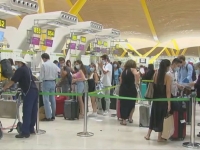Travel
Spain received 47.6 million foreign tourists in the first seven months 2023
20.9% more than the previous year
USPA NEWS -
Between January 1 and July 31 of this year, Spain received 47.6 million international tourists, 20.9% more than in the same period of the previous year. According to the latest Survey of Border Tourist Movements (FRONTUR), foreign tourists spent 59,964 million euros, 25.3% more than in 2022.
Despite the good figure, the Spanish tourism sector has not yet recovered its pre-pandemic levels. Specifically, the number of foreign tourists during the first seven months of this year is 0.8% lower than that registered in 2019. However, in the month of July alone Spain received 10.1 million international tourists, a 11.4% more than in the same month of 2022 and 2.6% more than in July 2019, before the pandemic.
The countries that sent the most tourists to Spain between January 1 and July 31 were the United Kingdom, with around 9.8 million tourists and an increase of 16.9% compared to the same period in 2022; France, with more than 6.4 million tourists and an increase of 20%; and Germany, with more than 6 million tourists and an increase of 9.6%. Outside Europe, the increase in tourists from the United States stands out, 28.9%; Portugal, 18.5%; and Italy, 17.8%.
By region, the Balearic Islands are the preferred destination for international tourists. 24.1% of the total chose the archipelago in July to spend their holidays. They are followed by Catalonia, with 22.1% of the total, and Andalusia, with 13.3%. 2.4 million international tourists arrived in the Balearic Islands in July, 7.2% more than in the same month of 2022. The majority came from the United Kingdom and Germany. In the Valencia region, the number of tourists increased by 18.4%, while in Madrid it increased by 6.1% and in the Canary Islands, by 4%. The majority of international tourists arrived in Spain by air: nearly 7.9 million tourists, with an increase of 10.7%. 12.6% more tourists arrived by road; by sea, 24.5% more, and by rail, 33.3% more.
The number of tourists who chose market accommodation increased by 6.8% compared to the first seven months of 2022. Within this group, hotel accommodation grew by 1.5% and rental housing by 49%. For its part, accommodation in the homes of friends or family increased by 38.3%. In this sense, tourists staying in the homes of friends or family increased by 38.1% and those staying in homes they owned increased by 36.4%. Most tourists stayed in Spain for four to seven nights.
The average expenditure per tourist was 1,367 euros, with an annual increase of 4.4%. Average daily spending grew by 9% to 185 euros. The Balearic Islands, Catalonia and Andalusia accounted for the highest tourist spending in July, while Catalonia, the Canary Islands and the Balearic Islands did so in the cumulative total of the first seven months of the year. The main expense of international tourists in July was transportation, with 20.1% of the total and an increase of 29.9% compared to the same month in 2022. Accommodation and leisure activities were the next items with the highest spending. 90.5% of the total spending of international tourists was for leisure.
Liability for this article lies with the author, who also holds the copyright. Editorial content from USPA may be quoted on other websites as long as the quote comprises no more than 5% of the entire text, is marked as such and the source is named (via hyperlink).






